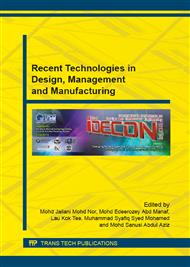p.421
p.426
p.431
p.436
p.441
p.447
p.452
p.457
p.462
Cure Characteristics of Natural Rubber/EPDM Blends for the Effect of MAH Grafted EPM and Compounding Parameters via Response Surface Methodology
Abstract:
Natural Rubber/EPDM blends were successfully prepared by direct melt compounding method using an internal mixer. The significance of MAH grafted EPM (MAH-g-EPM) and compounding parameters were studied via the response surface methodology (RSM) using the two-level full factorial design. The MAH-g-EPM loading, mixing temperature, rotor speed and mixing time were selected as four independent variables. Cure characteristics of scorch time, cure time and maximum torque were selected as the responses. The statistical significance of all variables and their interactions during compounding were analysed using ANOVA. The degree of agreement between experimental results with those predicted by the statistical model was confirmed using constant of determination, R2 with values approaching ~0.99. It was observed in the results, that the incorporation of high loading (10 phr) of MAH-g-EPM has predominantly enhanced the scorch safety time of NR/EPDM blends, as well as increased the modulus of NR/EPDM blends to some extent compared to low loading (5 phr and 7.5 phr). These finding were further supported by the Differential Scanning Calorimetry (DSC) analysis.
Info:
Periodical:
Pages:
441-446
Citation:
Online since:
May 2015
Price:
Сopyright:
© 2015 Trans Tech Publications Ltd. All Rights Reserved
Share:
Citation:


